From Győr to Madrid
A Biographical Sketch of Father Stanley Jaki
Antonio Colombo
Text of the lecture delivered at the Congreso Internacional “La relación ciencia-fe a la luz del pensamiento del P. Stanley L. Jaki” - Universidad Anáhuac - Mexico City - 18-20 March 2015 - with the Patronage of the Pontifical Council for Culture, and at the “Stanley Jaki Foundation International Conference” - Seton Hall University – Orange, NJ - 14-15 April 2015.
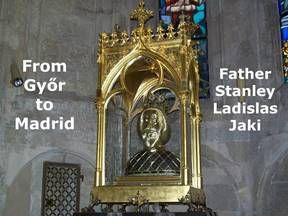
Győr is a town in Hungary. In its cathedral there is a reliquary of King St. Ladislas I, who reigned from 1077 to 1095. It is to this King that Father Jaki owes its second name, László, i.e. Ladislas. His first name, that sounded in Hungarian Szaniszló, before becoming Stanley in the USA, is the name of a holy bishop of Cracow (1072-1079). His Hungarian name is therefore Jaki Szaniszló László.
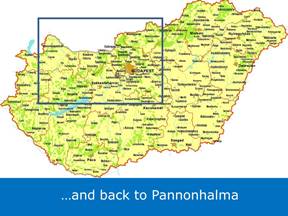
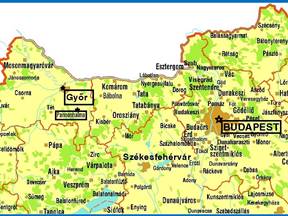
Győr is located east of Budapest, on the border with Slovakia. It is the sixth largest city of Hungary, nowadays it has about 130,000 inhabitants, but in 1924 it had only about 50,000. Father Jaki was born on August 17, 1924, the third of five children. South of Győr, and north of the Lake Balaton, is the Benedictine abbey of Pannonhalma, comparable in importance to the one at Monte Cassino in Italy. Here Father Jaki was buried, because, despite having spent most of his life in the United States of America, he always remained a monk belonging to the Pannonhalma Abbacy. And in Pannonhalma he ended up returning, to be buried with the other monks.
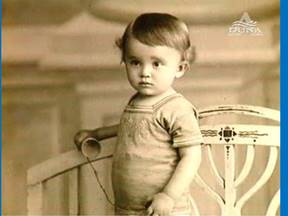
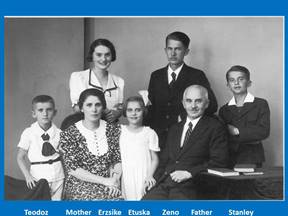
He was the third of five children, and had two sisters and two brothers. Of the two sisters, the older one is still living [2015], while Etuska died in 1942, of an illness, at the age of fifteen.
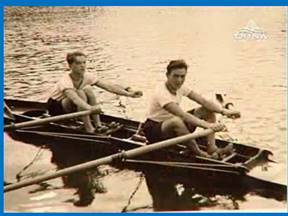
Father Jaki took part in sport as a young man. He was engaged in rowing. We also know that he starred in a dramatic society and that he was a Boy Scout. In the scouting organization he reached the title of Eagle Scout, the highest rank attainable by scouts who both show their understanding of the spirit of Scouting and succeed in a remarkable series of practical tests. Only about 1 in 40 scouts becomes an Eagle Scout.
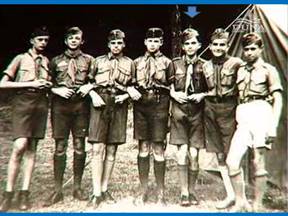

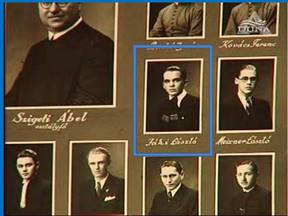
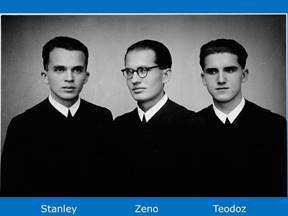
All the three Jaki brothers were called to a common, maybe not so common, vocation, which was to become a Benedictine monk. The brothers had attended a high school run by the Benedictine monks, in their hometown of Győr. Father Jaki entered the seminary at the end of high school, in 1942. Father Jaki said he felt that his vocation was the priesthood ever since the age of 7-8 years. The three brothers were destined to live rather different lives. The eldest, Zénó, never moved from Pannonhalma, holding various positions, including that of director of novices. He learned English in order to translate his brother’s works in Hungarian. He died in 2012. His younger brother, Teodóz, who died in 2013, was always interested in music, and spent his life in the Benedictine convent of Győr, directing religious choirs, but also making a work of great cultural interest. One of the Hungarian national disgraces, a direct result of the Treaty of Trianon of 1920, was the loss of parts of the territory to five neighbouring states. Father Teodóz traveled a lot in these areas, outside of present day Hungary, in view of the conservation of traditional Hungarian music, which risked being completely lost. By doing this he also achieved some fame, and received recognition from his motherland. Instead Father Jaki spent most of his life in another continent, America.
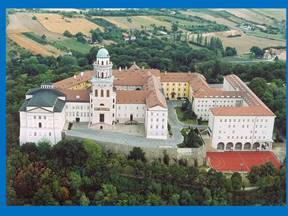
The Abbey in which Father Jaki formally remained throughout his life is that of Pannonhalma, in which he entered in 1942. His superiors decided, in September 1947, to send him to Rome to complete his theological studies. We must remember the climate of East Europe after the end of WWII. Hungary was becoming a country ruled by the Communists, and Father Jaki was able to travel to Italy just before freedom of movement was made almost impossible.
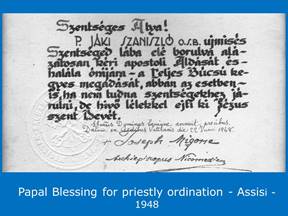
In Rome, he completed his studies at the Pontifical Athenaeum of St. Anselm, the Roman center of the Benedictine Order. He was ordained priest in 1948, in Assisi, by the Benedictine Bishop Mgr. Giuseppe Placido Nicolini.
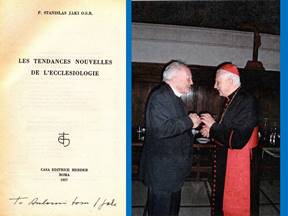
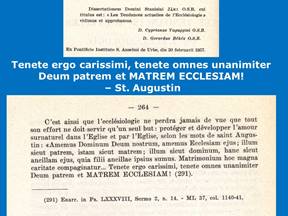
In December 1950 Father Jaki obtained a doctorate in theology with a dissertation thesis, written in French, about “new trends in ecclesiology” [1]. His thesis advisor was Mgr. Cipriano Vagaggini, a theologian who later contributed to the drafting of the conciliar document on the liturgy, Sacrosanctum Concilium. The thesis was later published (1957) and also had a second edition at the time of the Council. A review of this book was made at the time by the future Card. Ratzinger, who many years after said to the author: “Oh, Father Jaki, your Tendances, which I was most pleased to review, occupies a place of honor in my library.” [2]
From this book, which in a sense defines Jaki as a theologian, we report only the concluding quote from St. Augustine: “Hold then, most beloved, hold all with one mind to God the Father, and the Church our Mother.” [3] This love for the Church will generate several of his works, especially those dedicated to the primacy of Peter.
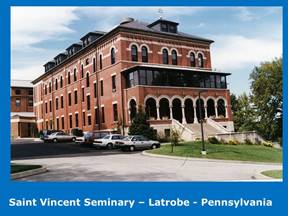
In 1949, Hungary got a constitution modeled on that of the Soviet Union. At the end of the Roman period, during which he learned enough Italian to make himself understood, Father Jaki expected to remain in Europe (perhaps in France, given his familiarity with the French language). Instead his superiors chose to send him to teach in the United States, a choice which determined his whole future life, but that did not depend at all on his own will. Father Jaki landed in America (in those days the crossing was made by ship) on December 21 1950. A week later he arrived at the Seminary of Saint Vincent, in Latrobe, Pennsylvania, and six months later began what was expected to be a career as a teacher. He taught French at the annex College, and theology at the seminary. In particular, his subjects included: De Deo Uno, De Deo Creante, De homine et gratia, and De Novissimis. These theological issues have, of course, vast ramifications, affecting both philosophy and science. So it was in this way that Father Jaki became interested in the problems of science, reading book after book by authors such as Eddington, a scientist himself, who also dealt with popularizing science. This lasted from 1951 up to the beginning of 1954. In the same period Father Jaki studied mathematics and physical sciences as well as American history and literature, and this allowed him to achieve, in 1954, the American title of Bachelor of Science, i.e. a degree in science.
A totally unexpected event was the reason for interrupting his activity as a teacher. On December 9, 1953 Father Jaki underwent a tonsillectomy, i.e. the common removal of the tonsils. A few days after surgery two subsequent bleedings supervened, and the practical consequences were that Father Jaki found himself almost voiceless for the next ten years. What little voice he had left was not enough for him to continue as a teacher, but it did not prevent him from continuing his studies. In 1954 Father Jaki also took American citizenship. So, when he returned for the first time to Hungary in 1964, he did this with an American passport.
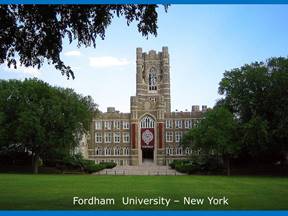
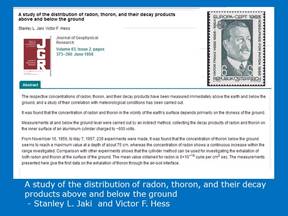
Having just completed a degree in science, the logical thing seemed to be to apply for a PhD, (Philosophiae Doctor) in Physics. This is what Father Jaki did, and got one in 1957, at Fordham University in New York, run by the Jesuits. Among his teachers was the winner of the Nobel Prize for Physics in 1936, Victor Hess. Between the two was born a sympathy, which resulted in a thesis prepared by Father Jaki under his direction and discussed in 1957. That thesis in turn resulted in an article signed by both, and published in the prestigious Journal of Geophysical Research [4]. The widow of Hess later confided to Father Jaki that Hess had in his heart a special place for Father Jaki. The dissertation was entitled Radon, Thoron [which are rare gases], and Their Decay Products Above and Within The Earth’s Surface. Although the title may sound rather abstract, it is known that these gases are one of the causes of lung cancers, a cause second only to cigarette smoking. This is, by his own admission, the only experimental scientific activity Father Jaki ever made.
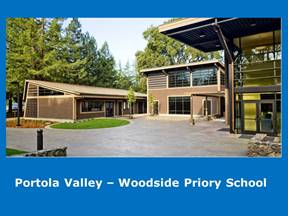
After getting his PhD, Father Jaki was ordered to move to Portola Valley, California, close to Stanford University, where he founded a school with other Benedictines, the Woodside Priory School. As his voice was always very low, Father Jaki took care of the administrative part, and, incredible dictu, was the driver of the station-wagon that served as a school-bus for some students of the school. Father Jaki had at that time developed the idea that the problem of the relation between science and religion had much to do with the historical aspects of the matter. The proximity of Stanford University, whose library is well stocked, allowed him to probe many aspects of the history of science, a subject to which real scientists paid little or no attention. His doctoral thesis had convinced Father Jaki that science had to do with exact measurements and predictions, and that if one was not able to make such measurements, it was not science, or at least not exact science. This insight would then help him in producing his own definition of science as “the quantitative study of the quantitative aspects of things in motion.” [5] Or, as Eddington put it: “The cleavage between the scientific and the extra-scientific domain of experience is, I believe, not a cleavage between the concrete and the transcendental, but between the metrical and the non-metrical.”
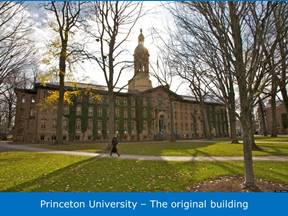
In 1960 Father Jaki moved near to another of the major American universities, Princeton, on the East coast of the United States. In this university, between 1961 and 1963, he worked on a project for the History of Science, as a Visiting Fellow.
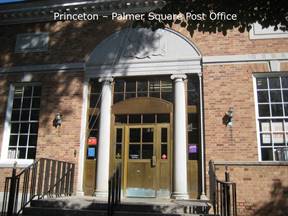
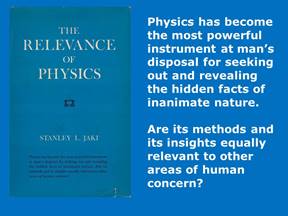
It was here that in 1962 he conceived the idea of his seminal work, The Relevance of Physics. The “idea flashed through my mind as I walked down from the steps of Princeton’s Post Office on Palmer Square.” [6] This Post Office remained one of the fixed points in the life of Father Jaki. In fact, inside it he rented a P.O. Box (P.O. Box 167) that he used as his surface mail address up to the end of his life. In a sense, the preparation of The Relevance had been going on for several years, since it was the result of all the historical investigations he had carried out in previous years. It took about three years to write it, and it was published in 1966. On the cover is written: “Physics has become the most powerful instrument at man’s disposal for seeking out and revealing the hidden facts of inanimate nature. Are its methods and its insights equally relevant to other areas of human concern?” [7] The answer, of course, is negative, which is why Father Jaki joked that the title should have been instead The Irrelevance of Physics! The book begins with a discussion of the three models of interpretation of the universe, the ancient Greeks’ organismic one, the Newtonian mechanistic, and the contemporary, based on mathematics. Then there are chapters which review the relation of physics with biology, metaphysics, ethics, and theology.
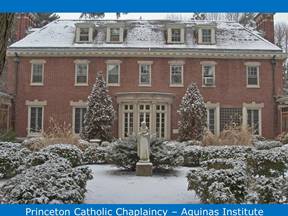
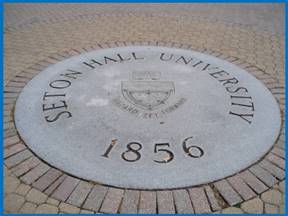
In 1965, while The Relevance of Physics was already in draft at a major American publisher (Chicago University Press) the Dean of Seton Hall University, visited the Catholic Chaplaincy at Princeton University where Father Jaki lived, and offered him to work as a university professor, with only the requirement to hold a seminar on a weekly basis, and with the unwritten mandate to keep writing. This is the way Father Jaki entered Seton Hall, the Catholic University of New Jersey, which is just over an hour’s drive from Princeton (forty miles, pretty close to Newark, just below New York). Father Jaki defined this turning point in his life as his becoming damnatus ad litteras, that is, condemned to write, something comparable to the Roman damnatus ad metalla that is condemned to hard labor in the mines.
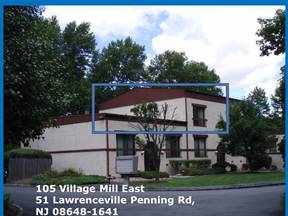
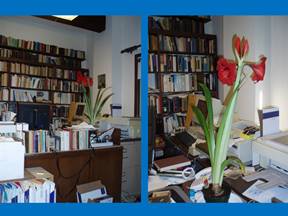
Father Jaki never moved to a location closer to Seton Hall for a fundamental reason, namely the availability of books in the libraries of Princeton. He obtained permission from his superiors not to live in a convent, and settled first in a basement that a widow rented to students of the university, and later in an apartment that the same widow rented him for the rest of his life. The flat was in Lawrenceville, a ten minute drive from Princeton. The apartment, in fact, was almost entirely occupied by books... He kept an old PC in order to be able to print what he wrote in “book” format (that is, as it would appear on the “real” book, with the proper font, page numbering, endnotes and so on). Father Jaki “converted” to use a PC for writing in 1990, and from then onward he always wrote using a computer (after having prepared a short handwritten outline of the book to be). However, he remained faithful to the word processor with whom he had started writing, called Word-Perfect and that’s why he needed the old 386 PC, the only one able to print files from the version of Word-Perfect Father Jaki used for all his life. The backup of nearly 550 diskettes he left occupies about 135 MegaBytes, even if many files are present in multiple copies. Bearing in mind that what Father Jaki wrote before 1990 is not available in electronic format, it can be estimated that his “production” amounts to about 100 Megabytes, i.e., in human terms, to a hundred books (the full text of the Bible occupies about 5 Megabytes).
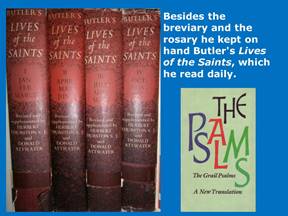
Father Jaki used to say Mass every day, early in the morning, before starting his working day. He was faithful to the breviary, whose psalms he read using the Grail translation [8] (he also wrote two commentaries on the psalms) [9]. He liked very much the collection of the lives of the saints prepared by Butler and updated by Father Thurston,[10] ordered by day, for each day of the year. He kept a copy of the four volume edition on hand in his bedroom, and read every day the “saints of the day.” He also recited the rosary every day, and almost every day paid a visit to the Church of the Catholic parish in Princeton, where he often made a prayer stop at the altar of St. Anthony of Padua.
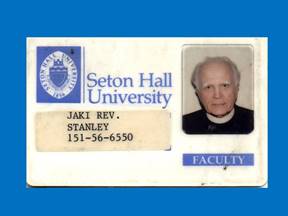
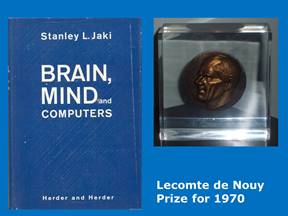
When Father Jaki died he was still part of the teaching body of Seton Hall, although he had long since passed the age of retirement. Father Jaki regularly visited every week Seton Hall. The number on the Seton Hall Badge is his Social Security Number. The first important book that followed The Relevance was Brain, Mind and Computers [11], which earned him the Lecomte du Nouy Prize in 1970.
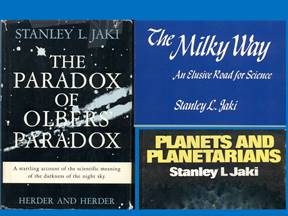
In subsequent years the issues he addressed in his books were mainly related to the history of astronomy: The paradox of Olbers[12], i.e. the explanation of why the night sky is dark and not as clear as during the day. If the universe were homogeneous and infinite, the laws on the diffusion of the light would require the night light being equal to the day light, and certainly it is not so. Another book concerned the Milky Way[13], one of the causes of the abandonment of the Aristotelian view of the cosmos, after Galileo realized that it was not a way at all, but a cluster of stars, which actually is our galaxy. Another book dealt with the theories of planetary formation[14].
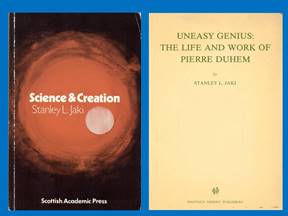
In parallel to these studies, faithful to the idea that the problems concerning the relation between science and faith depended very much on the historical circumstances, Father Jaki in 1974 produced a work, Science and Creation [15], which examined the reasons for the failed rise of science in all ancient civilizations, and for its only birth in the (Christian) European civilization, starting from the Middle Ages. One of the impressive points common to all ancient civilizations is a cyclical idea of time, a generalization of the cycle of the seasons, which, through the idea of the “great year”, supposed that all would one day restart over, and for this reason it was useless to try to study how the world worked. Only the Judeo-Christian concept of time was a linear one, with a beginning, creation, and one development in time until the return [for Christians] of Christ. When researching the history of the birth of science, Father Jaki started to appreciate the work of Pierre Duhem, a French Catholic physicist who lived between the nineteenth and twentieth century, and to whose historical research we owe the first information on the medieval origins of modern science. Duhem is the author of a monumental work, in 10 volumes, Le Système du Monde [16], the history of cosmological doctrines from Plato to Copernicus. Father Jaki “adopted” this scholar, and he also wrote his biography in 1984,[17] tracking down in France original documents related to him. Father Jaki then devoted other books both to Pierre Duhem[18] and to his daughter Hélène [19], who carried on the difficult task of completing the publication of the last volumes of the Système du monde after the death of her father. Duhem, who was a devout Catholic, was greatly opposed by the very secular French academia, which prevented him from obtaining, as he deserved, a place as a teacher in Paris rather than in Bordeaux.
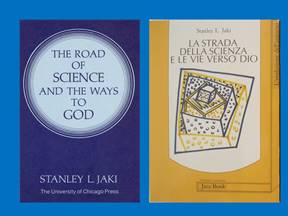
In the Seventies Father Jaki was asked to give for two consecutive years (1974/75 and 1975/76) the Gifford Lectures in Edinburgh, which had been established to foster and promote the study of natural theology in the broadest sense of the term or, in other words, the natural knowledge of God. Other illustrious personalities, religious and not, including Étienne Gilson, had already been invited to give the same Lectures. Father Jaki prepared a course on the history of science, showing how a moderate realism (as a philosophical background) had always accompanied the most significant scientific discoveries. Out of these lessons came the book The Road of Science and the Ways to God, [20] published in 1978. Needless to say, realism, from Aristotle to St. Thomas and the neo-Thomists, is part of the philosophical heritage of the Catholic Church and, in particular, it was promoted by Pope Leo XIII. One of the battles of Father Jaki was against those who tried to unite the vision of St. Thomas with the idealism of Kant, clearly incompatible with the former. Father Jaki coined a term to describe this category of philosophers: “Aquikantists”. The best known of these was Karl Rahner. Incidentally, although Father Jaki had already published articles in Italian in 1978, the Gifford Lectures book is his first major book translated into Italian, published by Jaca Book in 1988 [21]. It is through the Italian version of this book, that this writer came into contact with the thought of Father Jaki, and it was love at first sight...
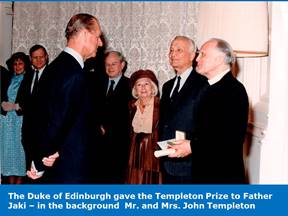
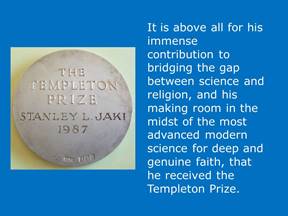
The reason why the Jaca Book publishing house decided to translate The Road of Science is pretty simple. Alfred Nobel, who originated the Nobel prizes, although nominally a Lutheran, was not particularly religious. That is why there is no Nobel Prize for religion, although occasionally the prizes for peace have been attributed to religious personalities (and at least one Nobel Prize for medicine was denied—to Jérôme Lejeune—solely because he was a Catholic). To remedy this shortcoming John Marks Templeton, an American/English businessman and philanthropist (1912-2008) established, in 1972, an award that bears his name, “for progress in religion”. Father Jaki was awarded this prize in 1987, and before him Mother Teresa, Brother Roger of Taizé, Card. Suenens, Chiara Lubich and others had received one. After he was awarded the Prize, Jaca Book decided to translate one of his books.
In addition to a medal, the prize consisted in a considerable amount of money. The dedication said, among other things: “Professor Stanley Jaki has offered the world, in a series of highly original and learned works, a reinterpretation of the history of science, which throws a flood of light on the relation between science and culture, and not least, the relation of science and faith.” [22] The dedication also speaks of his work in the field of astrophysics, which have highlighted the contingency of the universe, seen as an argument for the existence of God. It is also remembered that the study of science did not prevent him from being a deep theologian, and also mentioned are both the Lecomte du Nouy Prize, and the Gifford Lectures. The concluding sentence, which we quote is: “It is above all for his immense contribution to bridging the gap between science and religion, and his making room in the midst of the most advanced modern science for deep and genuine faith, that he received the Templeton Prize.” [23] Father Jaki was also given several honorary degrees. The picture was taken in 1988, at the Saint Anselm College, Manchester, New Hampshire.
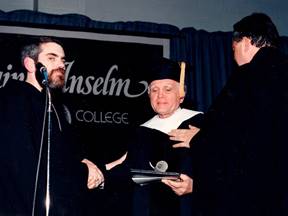
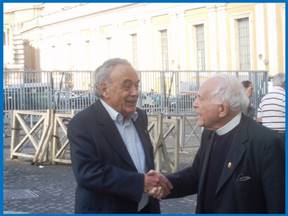
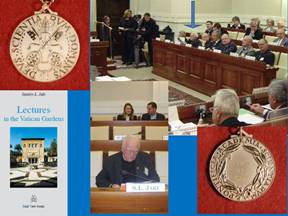
In 1990 Father Jaki was appointed as a Honorary Member (i.e. one of the members not directly engaged in scientific research) of the Pontifical Academy of Sciences, whose headquarters is located inside the Vatican Gardens. Father Jaki participated in almost all the plenary meetings of the Academy afterwards. The picture shows him in 2008, with Werner Arber, a Nobel Laureate in Medicine, then Vice-Presidente, and afterwards, up to the year 2017, President of the Academy. The interventions of Father Jaki to the Pontifical Academy of Sciences were published posthumously in 2011, under the title Lectures in the Vatican Gardens [24]. As an example we can recall his contribution on the unpredictability of science. Science is capable of making accurate predictions about the surrounding world, but it is not able to predict its own evolution. The motto of the Pontifical Academy of Sciences is Deus scientiarum Dominus, i.e. “God is the Lord of the sciences”.
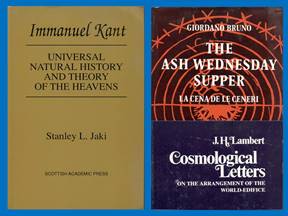
Father Jaki also prepared some translations of works not available in English, usually for “apologetic” purposes, as in the case of the juvenile work of Kant Universal Natural History and Theory of the Heavens [25]. The theses discussed in this work, especially those relating to the inhabitants of the other planets of the solar system, abundantly show how weak was the scientific training of Kant. The same applies to the translation of the The Ash Wednesday Supper of Giordano Bruno [26], who supports the Copernican theory, to demolish the Aristotelian cosmos, but denies the usefulness of exact measurements in science, something that highlights the limited scientific spirit of a person who still passes for a martyr of science. And Lambert’s Cosmological Letters [27], although important for the history of astronomy, fail as a result of not being based on experimental observations.
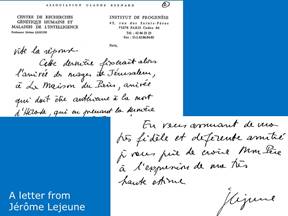
Father Jaki was in contact with several Nobel Laureates, and with some of them he was also a personal friend. There are traces of this correspondence, for example congratulations by Arno Penzias when Father Jaki received the Templeton Prize. We can also mention Sir John Eccles, and Steven Weinberg. In the correspondence of Father Jaki there are also letters from Jérôme Lejeune and Karl Popper. In 1976 Father Jaki was invited to a conference of Nobel Laureates held at Gustavus Adolphus College in Saint Peter, Minnesota. The proceedings, titled The Nature of the Physical Universe were published in 1979 by the publisher John Wiley [28].
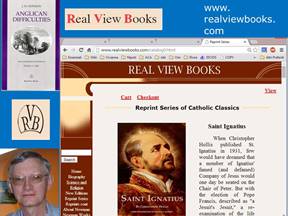
Father Jaki encouraged the translation into English of a number of works by authors such as Duhem and Gilson, but he also realized that some works worth knowing had become unobtainable, and decided to remedy this by founding a publishing house that could republish such works. This publishing company is called Real View Books and it is still in operation. The first book published was Anglican Difficulties [29], which reflects some conferences taught by Newman to convince his Anglican friends to overcome the difficulties that still prevented them from converting to Catholicism. Father Jaki’s “working method” was quite simple: for every new book to be published he found a benefactor who would pay out of pocket the live expenses of printing, in order to ensure the release of the book. About a hundred works of him are available today at the website of the publisher. The publishing house is physically hosted by a community of Dominican tertiaries, who dedicate their apostolate to the “good press”. They printed almost all the works of Father Jaki, starting from the early Nineties. The person who takes most active care of Real View Books is Dennis J. Musk, who was a friend and one of the main collaborators of Father Jaki.
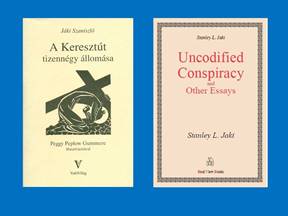
In parallel with Real View Books, Father Jaki founded in Hungary the publishing house ValóVilág (Real World), which published only translations of his books. After the death of Father Jaki, the publisher Real View Books has published the works of Father Jaki that he had left “print-ready”, but had not had time to publish. The last to come out of such books, printed in 2014, is a collection of twenty-two essays, entitled Uncodified Conspiracy and Other Essays [30]. The essay that gives the title to the collection (Uncodified Conspiracy) is a preface written by Father Jaki to the History of Jacobinism [31], a book written by Abbot Barruel, and published by Real View Books. A collection of essays on Newman is in the process of being printed (2018), and, after that, attention will be given to reprints of books of Father Jaki that went out of print.
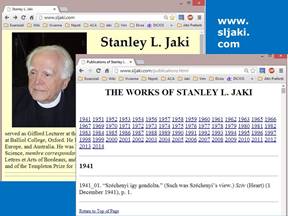
A second site, in addition to the one of Real View Books, is dedicated to Father Jaki: http://www.sljaki.com. This is the site where one can find information about Father Jaki. It is on this site that is kept an up-to-date list of publications of Father Jaki, consisting of over seven hundred item, that include books, articles, prefaces, reviews and translations. The site is the one Father Jaki himself decided to put online, in 2002.
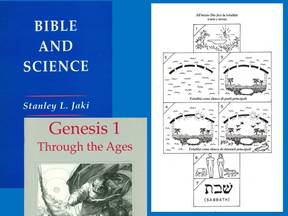
A series of books of Father Jaki is dedicated to the interpretation of the Bible. His main work in this regard is Bible and Science (1996) [32], which was followed, in 1998, by Genesis 1 Through the Ages [33], a book entirely devoted to the history of the comments to the first chapter of Genesis, which contains the story of creation. After a long discussion of the history of the interpretations of that chapter, Father Jaki concludes that the main objective of the chapter, in addition to the presentation of God as creator, is the one that concludes the narrative: “So God blessed the seventh day and made it holy, because on it he rested from all the work he had done in creation.” [34] The period of time in which the chapter reached its final form, after the return from exile in Babylon, had the need to motivate the population to start following again the traditional customs, i.e. circumcision and the Sabbath rest. God is then used as an example of the Sabbath rest, after he has done the greatest work imaginable, namely the creation of the universe, which is viewed, according to the cosmological concepts then current in the area, as the construction of a large tent, having as roof the firmament, above which were waters, and which also rested on water. Earth was viewed as a cosmic tent. His biblical books also deal with miracles, and Father Jaki has devoted an entire book to the miracle of the sun at Fatima [35], and another booklet to Our Lady of Guadalupe [36].
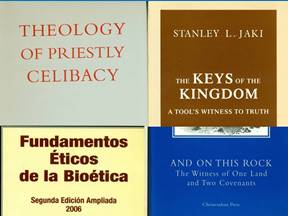
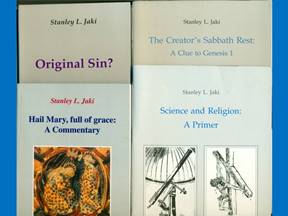
Father Jaki also devoted some books to the defense of the Catholic positions as being in perfect harmony with the teaching of the Magisterium. Particularly original is the book dedicated to the keys of St. Peter and their meaning [37]. We list here only the books about the primacy of Peter [38], priestly celibacy [39], bioethics [40], the defense of the Encyclical Humanae Vitae [41] of Pope Paul VI, and the Catholic position on the impossibility of a female priesthood [42].
In the last years of his life Father Jaki treated succinctly some basic topics of theology, and wrote commentaries on a number of Catholic prayers and litanies. In parallel Father Jaki wrote a series of booklets, thirty-two pages long, many of which explain briefly the theme of some of his books, while others are short monographs.
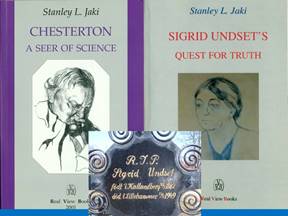
Another of the favorite authors of Father Jaki was Gilbert Keith Chesterton. To him Father Jaki has devoted several articles, but only one book, Chesterton, a Seer of Science [43]. Recall that Chesterton was anything but tender with the Scientism that dominated his era. Another book by Father Jaki was devoted to the conversion to Catholicism of the 1928 winner of the Nobel Prize in Literature, Sigrid Undset [44]. Both of these authors were converts, and Father Jaki had a particular attention to the converts, who often demonstrate in their new faith a more lively intellectual acumen and apologetic than “cradle Catholics”. The research done on the conversion of Sigrid Undset was a particularly laborious undertaking, which required also the translation for the first time of some of Undset’s texts from Norwegian into English. Father Jaki also visited the places where Sigrid Undset lived.
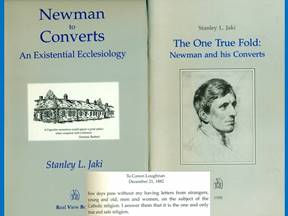
But the convert with whom Father Jaki has spent most time is undoubtedly the Blessed Cardinal John Henry Newman, the most illustrious convert of the nineteenth century. Father Jaki quoted him for the first time in his thesis. To Newman Father Jaki has dedicated several books and dozens of articles and lectures. He also put back in print some works of Newman that were almost impossible to find. One of his concerns was to prevent Newman being transformed into a precursor of ecumenism, especially of the kind in vogue after the Second Vatican Council, which tends to minimize the doctrinal differences with the Protestants. On this point, Father Jaki commented on some works of Newman, showing their deeply Catholic character and recalling the devastating judgments pronounced by Newman about the doctrine of justification of Luther [45], and about the Anglican Church [46]. Perhaps the most significant work of Father Jaki on this subject is Newman to Converts: An Existential Ecclesiology [47], the result of meticulous research carried out in Birmingham in Newman’s Library, and in which he details, inferring the material from letters to/from Newman and from documentation of the time, the events that led to the conversion of about twenty persons from Anglicanism to Catholicism. All these people had sought advice from Newman, and Newman gave the advice that may well be summed up in one of the sentences that can be found at the beginning of the book: “Few days pass without my having letters from strangers, young and old, men and women, on the subject of the Catholic religion. I answer them that it is the one and only true and safe religion.”
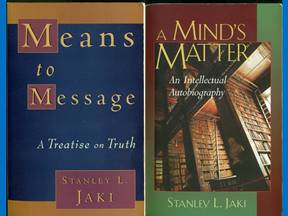
From the philosophical point of view Father Jaki appreciated a lot the positions of Gilson, whom he often quoted, and whom he considered “the greatest Thomist since Thomas Aquinas”, but to whom he devoted only a short essay. The key to understanding the philosophical position of Father Jaki is contained in two volumes, apparently very different in nature. The first one is an exposition of his philosophy, Means to Message (1999) [48]. The second one is his intellectual autobiography, A Mind’s Matter [49], which was printed in 2002, with two additional chapters published in 2006 and, posthumously, in 2011. A Mind’s Matter is very helpful for understanding the path taken by Father Jaki along his life, while Means to Message is a systematic philosophical exposition. Father Jaki tried in Means to Message to name each chapter with a title formed using a single word, but had to make an exception for “Free Will”.
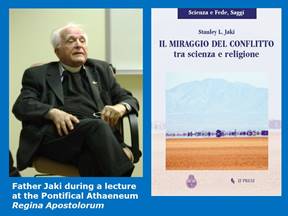
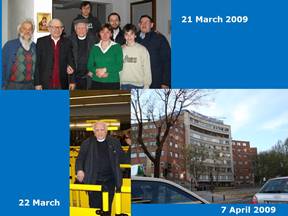
Father Jaki died in 2009. In March, he went to Rome to the Pontifical Athenaeum Regina Apostolorum, to give what would have been his last lectures. Since his lectures in Rome had to be kept a week away from each other, on the weekend between the first four and the second four lessons he came to Varese, to visit me and other friends, and it was the last time we could talk. After returning to Rome, in the following days, Father Jaki felt very unwell, but insisted, against the advice of doctors and friends, to continue with his program, which included a stop in Madrid before returning to the United States. In Madrid friends who welcomed him realized that he was in need of immediate medical assistance, and he was at once rushed to the nearby Clinica de la Conception, to the intensive care unit. Father Rafael Pascual went to Madrid on the following day, and was among the last to be able to talk with him. Doctors in Madrid found out that in Rome Father Jaki had suffered a heart attack and that his heart had been damaged. After a first operation, doctors inserted a tube for breathing and sedated him, in the hope of seeing an improvement that would allow for a second heart operation. Unfortunately, there was no improvement, and Father Jaki died on April 7, 2009, before the eyes of four friends, who held him and held hands while reciting prayers in three different languages.
Father Jaki died on the Tuesday of the 2009 Holy Week. The transportation of his body to Hungary could only take place the following week. The funeral itself took place in Pannonhalma even later, on April 29 2009. At the funeral were present people coming literally from around the world. There was the president of the Hungarian Academy of Sciences. The Arch-Abbot of Pannonhalma agreed that some people would be able to say a few words before the end of the rite. I happened to be one of them, and I said, among other things, “Father Jaki liked to quote the words of St. Paul about the ‘reasonable worship’ that we have to offer to the Lord; and his life was an example of this ‘reasonable worship’. Along with other friends, we will attempt to keep alive the memory of his life and his work.”
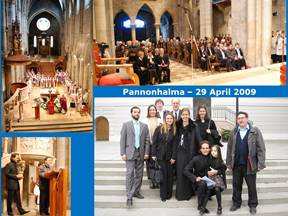
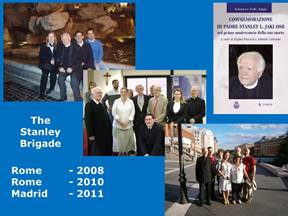
The group of friends of Father Stanley Jaki is called informally the Stanley Brigade; the name emerged in late 2008 in Rome. Father Jaki’s friends are scattered in different countries, and are busy locally. The group is open to anyone interested. In Rome, Father Paul Haffner, the first biographer of Father Jaki, is responsible for the Jaki Foundation. A first gesture organized by friends, and in particular by Father Rafael Pascual, was a conference in Rome in 2010, whose proceedings became available in 2014 [50]. A Summer School was held in Madrid in 2011. After the death of Father Jaki Real View Books has completed [2019] the publication of his books in English, that were already “print-ready” at the moment of his death, and translations and reprints appeared also in English, Italian, French, and Hungarian.
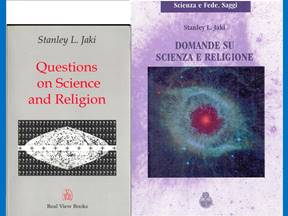
Singling out a book one could choose to start approaching Father Jaki I would suggest Questions on Science and Religion (2004) [51]. In this work, whose writing took several years (a few chapters had already been written in 1999), are condensed the answers Father Jaki gave in more detail in several other works. It is therefore a very good starting point.
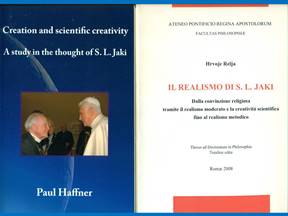
While Father Jaki was still alive, Father Paul Haffner wrote a thesis about him at the Pontifical Gregorian University, under his supervision and that of Fathers Welten and O’Collins, that was defended and published as a thesis in 1987 and subsequently published as a book in 1991: Creation and Scientific Creativity: A Study in the Thought of S.L. Jaki [52]. A new enlarged and updated edition came out in 2009 [53], a few months after the death of Father Jaki. A student of the Ateneo Pontificio Regina Apostolorum, Hrvoje Relja, has also prepared a thesis, in Italian, about Father Jaki, under the supervision of the Fathers Paul Haffner and Rafael Pascual, and this thesis, titled Il Realismo di S.L. Jaki, was published in 2008 [54].
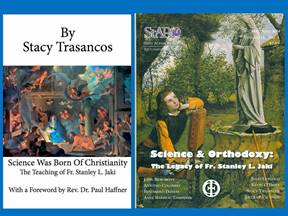
At the end of 2013 another thesis about Father Jaki was prepared by Stacy
Trasancos in the United States, and is available both in Kindle and in print
edition. The title is Science was Born of Christianity: The Teaching of Fr.
Stanley L. Jaki, published in 2014. Father Paul Haffner wrote a foreword
for both the thesis and the book.
Thanks to John Beaumont, the May/June 2014
issue of the Saint Austin Review [55]
(often referred to as “StAR”) is devoted almost entirely to Father Jaki.
Inside the magazine there is, in addition, an unusual contribution, due to
Kevin O’Brien, an actor by profession, but who puts his art at the service of
evangelization. Kevin “played” Father Jaki at a theological conference in 2012.
The text he composed and used is actually an anthology of quotes from various
works of Father Jaki, which Kevin documented very carefully, and his
interpretation, available on Youtube, is very convincing.
Both the text and the presentation can be reached from
the site http://www.sljaki.com, where some other
particulars relating to Father Jaki are also available.
[1] Stanley Jaki, Les tendances nouvelles de l’ecclesiologie (Rome: Herder, 1957).
[2] Stanley Jaki, Justification as Argued by Newman (Port Huron, MI: Real View Books, 2007), 269, note 7.
[3] Jaki, Les tendances nouvelles, 264, The statement is in the Latin original in the book: Tenete ergo carissimi, tenete omnes unanimiter Deum patrem et MATREM ECCLESIAM. The quote is taken from Saint Augustine’s Enarrationes in Psalmos, LXXXVIII, Sermo 2, n. 14.
[4] Stanley Jaki, Victor F. Hess, “A Study of the Distribution of Radon, Thoron, and Their Decay Products above and below the Ground”, in Journal of Geophysical Research, 63 (1958), 373-90.
[5] See, e.g., Stanley Jaki, The Drama of Quantities (Port Huron, MI: Real View Books, 2005), 13. The Eddington’s quote comes from The Nature of the Physical World (New York: MacMillan; Cambridge: Cambridge University Press, 1929), 275.
[6] Stanley Jaki, A Mind’s Matter: an Intellectual Autobiography (Grand Rapids, MI: Eerdmans, 2002), 22. The Post Office itself remained in use up to the year 2015, then was moved to a nearby location.
[7] Stanley Jaki, The Relevance of Physics (Chicago: The University of Chicago Press, 1966), cover.
[8] The Psalms: A New Translation (London: Collins, 1963).
[9] Stanley Jaki, Praying the Psalms (Grand Rapids, MI: Wm. B. Eerdmans, 2000). Stanley Jaki, Themes of Psalms (Port Huron, MI: Real View Books, 2005).
[10] Herbert Thurston SJ, Donald Attwater, Butler’s Lives of the Saints (London: Burns & Oates, 1956).
[11] Stanley Jaki, Brain, Mind and Computers (New York: Herder and Herder, 1969).
[12] Stanley Jaki, The Paradox of Olbers’ Paradox: A Case History of Scientific Thought (New York: Herder and Herder, 1969).
[13] Stanley Jaki, The Milky Way: An Elusive Road for Science (New York: Science History Publications; Newton Abbot: David and Charles, 1972).
[14] Stanley Jaki, Planets and Planetarians: A History of Theories of the Origin of Planetary Systems (Edinburgh: Scottish Academic Press; New York: The Halstead Press of John Wiley Inc., 1978).
[15] Stanley Jaki, Science and Creation: From Eternal Cycles to an Oscillating Universe (New York: Science History Publications; Edinburgh: Scottish Academic Press, 1974).
[16] Pierre Duhem, Le Système du Monde: histoire des doctrines cosmologiques de Platon à Copernic (Paris: Hermann, 1913-1959).
[17] Stanley Jaki, Uneasy Genius: The Life and Work of Pierre Duhem (Dordrecht/Boston/Lancaster: Martinus Nijhoff, 1984).
[18] Stanley Jaki, The Physicist As Artist: The Landscapes of Pierre Duhem. (Edinburgh: Scottish Academic Press, 1988). Stanley Jaki, Scientist and Catholic: an Essay on Pierre Duhem (Front Royal, VA: Christendom Press, 1991).
[19] Stanley Jaki, Reluctant Heroine: The Life and Work of Hélène Duhem (Edinburgh: Scottish Academic Press, 1992).
[20] Stanley Jaki, The Road of Science and the Ways to God: The Gifford Lectures 1975 and 1976 (Chicago: University of Chicago Press; Edinburgh: Scottish Academic Press, 1978).
[21] Stanley Jaki, La strada della scienza e le vie verso Dio (Milan: Jaca Book, 1988).
[22] Templeton, 1987 Templeton Prize (Nassau, Bahamas: Lismore Press, 1987), 4.
[23] Ibid.
[24] Stanley Jaki, Lectures in the Vatican Gardens (New Hope, KY: Real View Books, 2011). Chapter 9 of this book is about “Science as Prediction and the Unpredictability of Science.”
[25] Stanley Jaki, Translation from the German, with an Introduction and Notes, of: Immanuel Kant. Universal Natural History and Theory of the Heavens (Edinburgh: Scottish Academic Press, 1981).
[26] Stanley Jaki, Translation from the Italian, with an Introduction and Notes, of: Giordano Bruno. The Ash Wednesday Supper (The Hague/Paris: Mouton, 1975).
[27] Stanley Jaki, Translation from the German, with an Introduction and Notes, of: J.H. Lambert. Cosmological Letters on the Arrangement of the World-Edifice (New York: Science History Publications; Edinburgh: Scottish Academic Press, 1976).
[28] Stanley Jaki, “The Chaos of Scientific Cosmology.” In: Douglas Huff and Omer Prewett (eds.). The Nature of the Physical Universe: 1976 Nobel Conference (New York: John Wiley, 1979), 83-112.
[29] John Henry Newman, Anglican Difficulties (Certain Difficulties Felt by Anglicans in Catholic Teaching) (reprint of 1850 edition) (Fraser, MI: Real View Books, 1994).
[30] Stanley Jaki, Uncodified Conspiracy and Other Essays (New Hope, KY: Real View Books, 2014).
[31] Augustin Barruel, Memoirs Illustrating the History of Jacobinism (Fraser, MI: Real View Books, 1995).
[32] Stanley Jaki, Bible and Science (Front Royal, VA: Christendom Press, 1996).
[33] Stanley Jaki, Genesis 1 Through the Ages (Edinburgh: Scottish Academic Press; Royal Oak, MI: Real View Books, 1998).
[34] Gen 2:3.
[35] Stanley Jaki, God and the Sun at Fatima (Fraser, MI: Real View Books, 1999).
[36] Stanley Jaki, The Drama of Guadalupe (New Hope, KY: Real View Books, 2009).
[37] Stanley Jaki, The Keys of the Kingdom: A Tool’s Witness to Truth (Chicago: The Franciscan Herald Press, 1986).
[38] Stanley Jaki, And on This Rock: The Witness of One Land and Two Covenants (Notre Dame, IN: Ave Maria Press, 1978).
[39] Stanley Jaki, Theology of Priestly Celibacy (Front Royal, VA: Christendom Press, 1997).
[40] Stanley Jaki, The Ethical Foundations of Bioethics (Port Huron, MI: Real View Books, 2007).
[41] Stanley Jaki, The Background of Humanae Vitae: Peter’s Chair: a Professorial Chair? (Gaithersburg, MD: Human Life International, 1993).
[42] Stanley Jaki, “Authoritatively No-Authority to Ordain Women” The Wanderer (30 June 1994).
[43] Stanley Jaki, Chesterton: A Seer of Science (Urbana/Chicago: University of Illinois Press, 1986).
[44] Stanley Jaki, Sigrid Undset’s Quest for Truth (Port Huron, MI: Real View Books, 2007).
[45] Jaki, Justification as Argued by Newman.
[46] Stanley Jaki, The Church of England as Viewed by Newman (Pinckney, MI: Real View Books, 2004).
[47] Stanley Jaki, Newman to Converts: An Existential Ecclesiology (Pinckney, MI: Real View Books, 2001).
[48] Stanley Jaki, Means to Message: A Treatise on Truth (Grand Rapids, MI: Wm. B. Eerdmans, 1999).
[49] Jaki, A Mind’s Matter.
[50] Rafael Pascual, Antonio Colombo (eds.), Atti del Convegno Internazionale – Commemorazione di Padre Stanley L. Jaki OSB, nel primo anniversario della sua morte (Rome: Ateneo Pontificio Regina Apostolorum – IF Press, 2014). Lucía Guerra Menéndez, Rafael Pascual, Antonio Colombo (eds.), Proceedings of the Summer Course Science and Faith in Stanley Jaki – Madrid, July 11-13, 2011 (Rome: Ateneo Pontificio Regina Apostolorum – IF Press – CEU, 2017).
[51] Stanley Jaki, Questions on Science and Religion (Pinckney, MI: Real View Books, 2004).
[52] Paul Haffner, Creation and Scientific Creativity: A Study in the Thought of S.L. Jaki (Front Royal, VA: Christendom Press, 1991).
[53] Paul Haffner, Creation and Scientific Creativity: A Study in the Thought of S.L. Jaki (Leominster: Gracewing, 2009).
[54] Hrvoje Relja, Il realismo di S.L. Jaki: Dalla convinzione religiosa tramite il realismo moderato e la creatività scientifica fino al realismo metodico (Rome: Ateneo Pontificio Regina Apostolorum, 2008).
[55] “Science & Orthodoxy; The legacy of Fr. Stanley L. Jaki”, Special issue of the Saint Austin Review, vol. 14, no. 3 (May-June 2014).